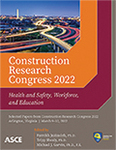Spatial Exposure to Dynamic Safety Hazards in Construction Sites through 360-Degree Augmented Panoramas: Ecological Validity in Safety Research
Publication: Construction Research Congress 2022
ABSTRACT
Given the dynamic and complex nature of the construction industry, maintaining situation awareness at job sites is critical. To react properly, workers must identify dynamic safety hazards within the scene. The majority of studies assessing construction workers’ situation awareness have utilized static images, virtual reality, and other types of simulation methods, but questions remain as to whether these formats are able to capture and monitor workers’ naturalistic behaviors and hazard identification abilities. To identify whether the format of hazardous stimuli (i.e., static, image-based vs. dynamic, and video-based formats) impact workers’ subjective and objective hazard identification and situation awareness metrics, this study developed 23 safety hazard scenarios utilizing state-of-the-art augmented 360° panoramas and then tracked differences in workers’ visual search patterns and hazard identification abilities using eye-tracking technology. The workers’ cognitive responses, evidenced by their eye movements, showed that workers had significantly varied cognitive processes and abilities depending on the format of stimuli: Workers with lower hazard identification skills were more likely to miss hazards in a dynamic environment. This result suggests that the experimental setting should be carefully designed to determine construction workers’ natural cognitive process.
Get full access to this article
View all available purchase options and get full access to this chapter.
REFERENCES
Aroke, O., Esmaeili, B., Hasanzadeh, S., Dodd, M. D., and Brock, R. (2020). “The Role of Work Experience on Hazard Identification: Assessing the Mediating Effect of Inattention under Fall-Hazard Conditions.” Construction Research Congress 2020, American Society of Civil Engineers, Reston, VA, 509–519.
Borowsky, A., Shinar, D., and Oron-Gilad, T. (2010). “Age, skill, and hazard perception in driving.” Accident Analysis and Prevention, Elsevier Ltd, 42(4), 1240–1249.
Eiris, R., Gheisari, M., and Esmaeili, B. (2020). “Desktop-based safety training using 360-degree panorama and static virtual reality techniques: A comparative experimental study.” Automation in Construction, Elsevier, 109(October 2019), 102969.
Guo, Z., Pan, Y., Zhao, G., Zhang, J., and Dong, N. (2020). “Recognizing hazard perception in a visual blind area based on EEG features.” IEEE Access, IEEE, 8, 48917–48928.
Hasanzadeh, S., Esmaeili, B., and Dodd, M. D. (2017a). “Impact of Construction Workers’ Hazard Identification Skills on Their Visual Attention.” Journal of Construction Engineering and Management, 143(10), 04017070.
Hasanzadeh, S., Esmaeili, B., and Dodd, M. D. (2017b). “Measuring the Impacts of Safety Knowledge on Construction Workers’ Attentional Allocation and Hazard Detection Using Remote Eye-Tracking Technology.” Journal of Management in Engineering, 33(5), 04017024.
Hasanzadeh, S., Esmaeili, B., and Dodd, M. D. (2018). “Examining the Relationship between Construction Workers’ Visual Attention and Situation Awareness under Fall and Tripping Hazard Conditions: Using Mobile Eye Tracking.” Journal of Construction Engineering and Management, 144(7), 04018060.
Holleman, G. A., Hooge, I. T. C., Kemner, C., and Hessels, R. S. (2020). “The ‘Real-World Approach’ and Its Problems: A Critique of the Term Ecological Validity.” Frontiers in Psychology, 11(April), 1–12.
Jeon, J., Cai, H., Yu, D., and Xu, X. (2020). “Identification of Safety Hazards Using Wearable EEG.” Construction Research Congress 2020, American Society of Civil Engineers, Reston, VA, 185–194.
Kaber, D., Jin, S., Zahabi, M., and Pankok, C. (2016). “The effect of driver cognitive abilities and distractions on situation awareness and performance under hazard conditions.” Transportation Research Part F: Traffic Psychology and Behaviour, Elsevier, 42, 177–194.
Li, J., Li, H., Wang, H., Umer, W., Fu, H., and Xing, X. (2019). “Evaluating the impact of mental fatigue on construction equipment operators’ ability to detect hazards using wearable eye-tracking technology.” Automation in Construction, Elsevier, 105(May), 102835.
Liao, P. C., Sun, X., and Zhang, D. (2021). “A multimodal study to measure the cognitive demands of hazard recognition in construction workplaces.” Safety Science, Elsevier Ltd, 133(August 2019), 105010.
Noghabaei, M., and Han, K. (2020). “Hazard Recognition in an Immersive Virtual Environment: Framework for the Simultaneous Analysis of Visual Search and EEG Patterns.” Construction Research Congress 2020, American Society of Civil Engineers, Reston, VA, 934–943.
Perlman, A., Sacks, R., and Barak, R. (2014). “Hazard recognition and risk perception in construction.” Safety Science, Elsevier Ltd, 64, 13–21.
Sacks, R., Rozenfeld, O., and Rosenfeld, Y. (2009). “Spatial and Temporal Exposure to Safety Hazards in Construction.” Journal of Construction Engineering and Management, 135(8), 726–736.
Scialfa, C. T., Borkenhagen, D., Lyon, J., and Deschênes, M. (2013). “A comparison of static and dynamic hazard perception tests.” Accident Analysis and Prevention, Elsevier Ltd, 51, 268–273.
BLS (U.S. Bureau of Labor Statistics). (2020). “Census of Fatal Occupational Injuries (CFOI).” <https://www.bls.gov/iif/oshcfoi1.htm#2019>(Jun. 3, 2021).
Wickens, C. D., Hollands, J. G., Banbury, S., and Parasuraman, R. (2015). Engineering psychology and human performance. Psychology Press.
Xu, Q., Chong, H.-Y., and Liao, P. (2019). “Exploring eye-tracking searching strategies for construction hazard recognition in a laboratory scene.” Safety Science, Elsevier, 120(July), 824–832.
Zhu, Y., Rodriguez-Paras, C., Rhee, J., and Mehta, R. K. (2020). “Methodological Approaches and Recommendations for Functional Near-Infrared Spectroscopy Applications in HF/E Research.” Human Factors: The Journal of the Human Factors and Ergonomics Society, SAGE Publications Sage CA: Los Angeles, CA, 62(4), 613–642.
Information & Authors
Information
Published In
History
Published online: Mar 7, 2022
Authors
Metrics & Citations
Metrics
Citations
Download citation
If you have the appropriate software installed, you can download article citation data to the citation manager of your choice. Simply select your manager software from the list below and click Download.
